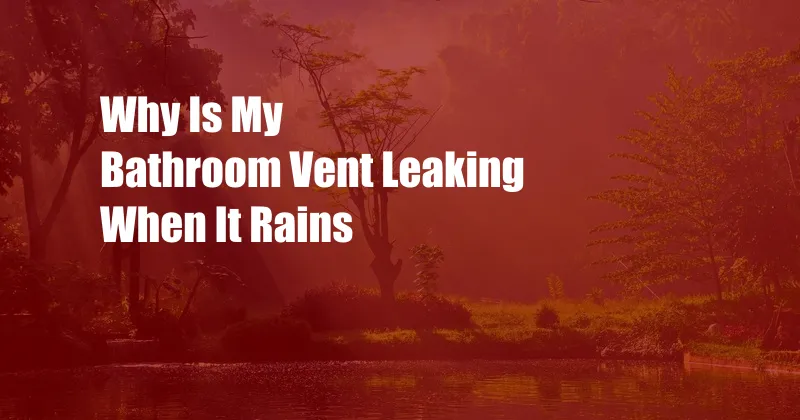
Why is My Bathroom Vent Leaking When it Rains?
The pitter-patter of raindrops can be a soothing melody, but not when it’s causing your bathroom vent to leak. This frustrating issue can damage your ceiling and walls, leaving you with a costly mess.
In this comprehensive guide, we’ll delve into the reasons behind a leaking bathroom vent during rainfall and provide expert advice on how to fix it. So, grab your tools and prepare to make your bathroom leak-proof.
Defective Flashing
Flashing is a crucial component that seals the vent pipe where it penetrates the roof. Over time, exposure to harsh weather can cause the flashing to become loose or damaged, allowing water to seep in.
When rain falls on a defective flashing, it can drip down into the vent pipe and end up inside your bathroom. To rectify this issue, inspect the flashing around the vent pipe. If it’s damaged, replace it with a new one.
Clogged Vent Pipe
A clogged vent pipe can prevent air from escaping properly, creating positive pressure inside the bathroom. When this happens, water from the rain or condensation can back up into the vent and leak inside.
To determine if your vent pipe is clogged, look for signs of debris blocking the opening. It could be leaves, twigs, or even bird nests. Use a long pole or brush to clear the obstruction and allow air to flow freely.
Improperly Installed Vent Cap
The vent cap is the topmost part of the vent pipe and its purpose is to prevent water from entering. If the vent cap is missing, damaged, or not properly installed, it can allow rain to seep into the pipe.
Inspect the vent cap and make sure it’s securely attached to the pipe. If it’s damaged, replace it with a new one. While installing the new cap, ensure that it’s facing the right direction to deflect rainwater.
Damaged Roof Vent Boot
The roof vent boot is a rubberized seal that connects the vent pipe to the roof. Its function is to prevent water from leaking around the pipe and entering the attic or bathroom.
Over time, the roof vent boot can become torn or cracked, allowing water to seep in. To fix this, inspect the boot for damage and replace it if necessary. Make sure the new boot fits snugly around the vent pipe and the roof surface.
Tips and Expert Advice
To prevent future leaks, consider the following expert tips:
- Regularly clean your bathroom vent to remove any lint or debris that could clog the pipe.
- Inspect the vent pipe, flashing, and vent cap every year for any signs of damage or wear.
- If you’re not comfortable working on the roof, hire a qualified roofing contractor to inspect and repair the vent system.
Frequently Asked Questions
Q: Can I seal the leak with caulk?
A: While caulk can temporarily stop a leak, it’s not a permanent solution. It’s important to identify the underlying cause and address it to prevent the leak from recurring.
Q: Can a leaking bathroom vent damage my bathroom?
A: Yes, a leaking bathroom vent can cause extensive damage to your bathroom. Water can seep into the ceiling, walls, and floors, leading to mold growth, structural damage, and costly repairs.
Conclusion
No one wants to deal with a leaky bathroom vent, especially when it’s raining. By understanding the potential causes and following our expert advice, you can take proactive steps to prevent leaks and ensure your bathroom stays dry and leak-free. Remember to check your bathroom vent regularly and take action promptly if you notice any signs of damage or leaks.
Are you interested in learning more about bathroom ventilation systems? Leave a comment below and we’ll be happy to provide additional information and resources.